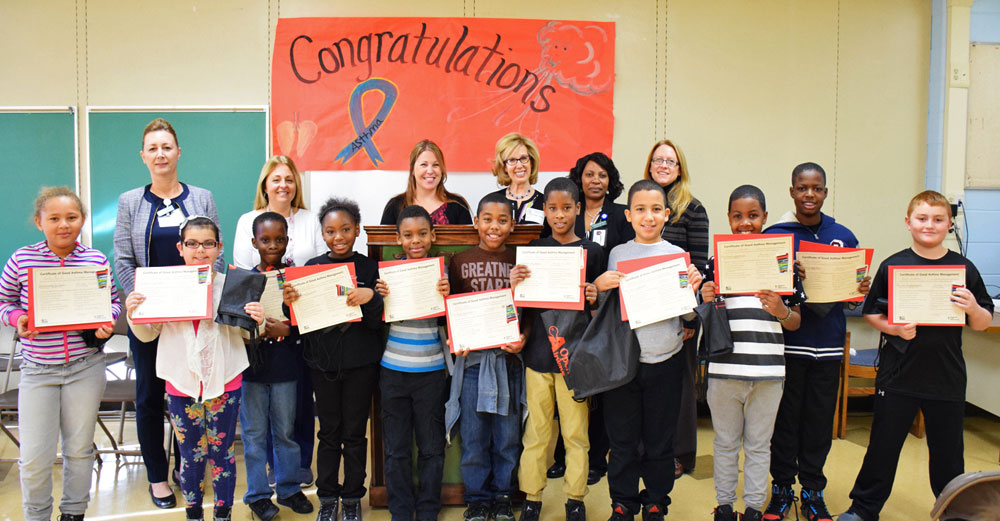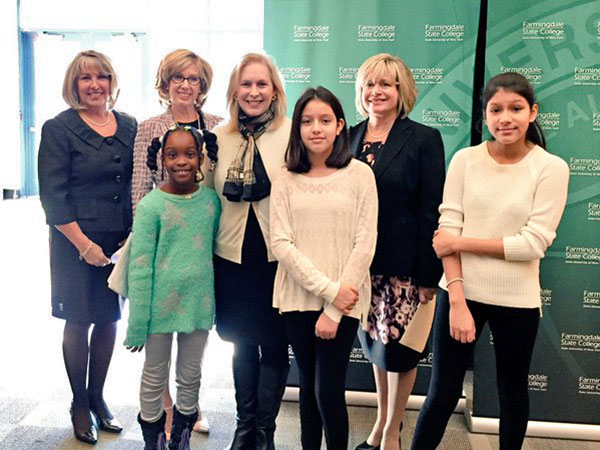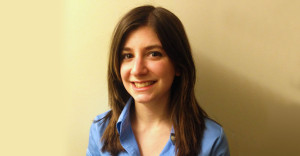
U.S. Senator Kirsten Gillibrand stood at the podium at Farmingdale State College recently to announce her latest piece of legislation, the School Asthma Management Plan Act, a bill that will provide $1.6 billion in funding to school districts from coast to coast to help them develop and implement programs that will help their students better manage their asthma.
Standing behind the senator was Farmingdale nursing Professor Monica Diamond-Caravella, smiling as broadly as anyone in the room.
That’s because Professor Diamond-Caravella has been working tirelessly for the last six years, helping bring asthma relief and education to more than 2,000 kids in grades K-12 across Long Island. She and her staff of Farmingdale nursing students and faculty, in partnership with the Asthma Coalition of Long Island, are also training school nurses, staff, coaches and teachers how to help students better manage their asthma, with the goal of keeping them in school and out of hospital emergency rooms.

It’s a huge job. According to the New York State Department of Health, 364,000 children in the state suffer from asthma; more than 56,000 of them live on Long Island. No one has a handle on how many school days have been missed by these suffering students, but the DOH says that 1,300 kids – mostly from families who are underserved by our health-care system – spent at least one night in a hospital in 2014.
Given the work still needed to be done, it’s no wonder Professor Diamond-Caravella was so excited to hear Senator Gillibrand speak with such passion about helping these children.
“The authorization of Senator Gillibrand’s School Asthma Management Plan Act comes at a pivotal time for New York State, given the restructuring of our healthcare delivery system and the focus on reducing avoidable hospital use,” she says. “Asthma is the third-leading cause of hospitalization for children, and grant monies to high-needs public school districts will greatly enhance coordinated efforts by Farmingdale State College and the Asthma Coalition of Long Island. Thank you Senator Gillibrand for your foresight.”
Senator Gillibrand is impressed with Professor Diamond-Caravella too. When a photo of Professor Diamond-Caravella and her students – at work at one of their target schools – came to the senator’s attention, Farmingdale was suddenly on her radar screen.
“Farmingdale State College and Professor Diamond-Caravella have done tremendous work in helping young people with asthma learn how to self-manage and identify triggers,” Senator Gillibrand said. “With nearly 1 in 11 children in our state now suffering from asthma, we have to make sure our schools have the resources to prepare for and prevent asthma attacks.”
Every seat at the event was filled; in fact, there was standing room only as Farmingdale nursing students and faculty, parents of children with asthma, asthma-care advocates and others showed up to hear the details of Senator Gillibrand’s bill. Funding kicks in in 2017, and school districts will be eligible for aid through 2020. Grant amounts will vary among school districts, with particular attention to districts with a high percentage of low-income students.
It turns out that Senator Gillibrand and Professor Diamond-Caravella have something else in common, besides their passion for assisting students with asthma. Both have family members who suffer from this chronic ailment: the senator’s 12-year-old son, and the professor’s husband and daughter.
Professor Diamond-Caravella’s concern for asthma sufferers merged with her work in 2010, when she joined Farmingdale’s nursing department after many years as an oncology clinical nurse specialist. She immediately began looking for an out-of-the-classroom initiative, and it all came together when she met Anne Little, director of the Asthma Coalition of Long Island. They bonded immediately, and a partnership was born.
“It was novel,” says Professor Diamond-Caravella. “It met all requirements for a meaningful clinical experience, it enhanced the concepts being taught in the classroom, and it actually had a primary focus of serving a population in need. It doesn’t get better than this for a community health educator.”
Soon the pair was looking for Long Island school districts to work with. They currently work with three, doing everything from training pre-kindergartners and kindergartners on how to help a friend with asthma, to training faculty – nearly 500 to date. Students in the field are working RN’s studying at Farmingdale for their baccalaureate degrees. The ACLI provides supplies and materials, and the program most often taught is the American Lung Association’s Open Airways for Schools, a program that educates and empowers children through a fun and interactive approach to asthma self-management. It teaches children with asthma ages 8 to 11 how to detect the warning signs of asthma, avoid their triggers and make decisions about their health.
The work – which takes place over six days during the students’ lunch period – is satisfying, says Professor Diamond-Caravella, because the children take it so seriously.
“The program includes interactive role playing and games to maintain the children’s attention,” she says. “At the end of the sessions, children are able to recognize their asthma triggers, report early symptoms of an asthma attack and understand the importance of their medications. The program is so effective that on ‘graduation day’ parents share how impressed their pediatricians and pulmonologists are with their children’s expanded knowledge in asthma self-management. It has been my experience over these past six years that close to 90% of students attend every session.”
The bottom line for Professor Diamond-Caravella: keep children from suffering, keep them in the classroom and keep them in their bedrooms – not a hospital bed.
“Our goal is to empower children to take control of their asthma. It is the most common chronic condition among children, and the third leading cause of hospitalization. It is a huge challenge for those of us in the health-care community and health education, who want to give the children in our communities a better quality of life.”



